Winter 2009
 |
||
Ten-year-old John Grayson got turned onto robotics at Carnegie Science Center’s SciTech Days and is now hooked on school.photo: Renee Rosensteel |
WELCOME
For many, a visit to a museum is a luxury, and an intimidating one at that. Others simply don’t realize the variety of resources museums have to offer. So Carnegie Museums is working harder than ever to reach out in order to bring more people in. By Jennifer Bails When eight children stepped out of a van raring to go at Carnegie Museums of Art and Natural History this past June, the moment symbolized a number of firsts.The trip marked the first time many of the kids had been outside of Alta Vista Children’s Shelter in Clarksburg, W.Va., since arriving there weeks beforehand seeking emergency refuge from abuse and neglect at home. It was also the first time many of them had ever left West Virginia. And for most of the youngsters, ages 6 to 13, culture shock came with a healthy dose of culture during their inaugural visit to a museum. Jaws wide open and necks craned upward, they caught their magical first glimpses of battling T. rexes and ancient mummies. They marveled at the masterworks in the Hall of Architecture and laid eyes on a Monet for the first time. “When we left, they all wanted to go back—especially to see the dinosaurs,” recounts Jesse Ash, a shelter worker who chaperoned the outing. The excursion was possible because of a program that provides ACCESS-card users—at-risk children, seniors, low-income families, and people with disabilities—$1 admission to any of the four Carnegie Museums, good for up to four people per visit. The museums began offering the discount four years ago, but not enough people knew about it to make a difference, explains Jara Dorsey, community outreach specialist at Carnegie Museum of Art. So late last year, Dorsey and her colleagues enlisted the state Department of Public Welfare and the Allegheny County Department of Human Services to help spread the word through mailings, fliers, and their websites. They also asked service providers to tell their clients about the offer. 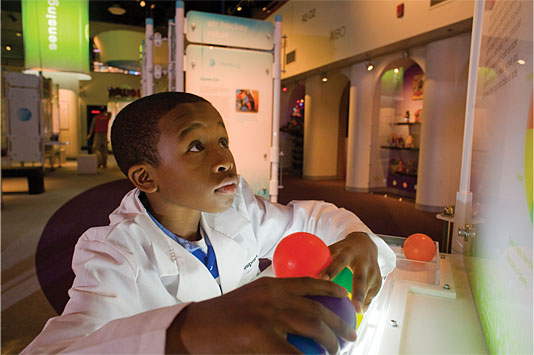 Photo: Renee Rosensteel“Through initiatives like the ACCESS-card program, we are getting closer to our founding principle that the museums are a gift to the city and that everyone can and should come and experience them.”
Jara Dorsey, community outreach specialist at Carnegie Museum of Art“It really started spreading through word of mouth,” says Dorsey, noting that more than 16,000 people have visited the museums through the program in just the first nine months of 2009—compared to 1,027 ACCESS admissions the entire previous year. The offer is just one of the many ways Carnegie Museums is working to broaden access to its priceless resources for those who might not otherwise take advantage of them—from disadvantaged children, to college students intimidated by the museum setting, to teachers and homeschool parents who may not be fully aware of the wealth and diversity of educational programs available at all four museums. “Andrew Carnegie’s original idea was to make the museum free to the people,” Dorsey says. “With the changing times, we can’t make them free anymore, but through initiatives like the ACCESS-card program, we are getting closer to our founding principle that the museums are a gift to the city and that everyone can and should come and experience them.” Art and Science 101Among those who sometimes need an extra nudge to explore museums are college students. For many coeds, a visit to a museum can be bewildering, says Annabelle Clippinger, director of PITT ARTS, a program that aims to connect University of Pittsburgh students with the city’s vibrant arts community. “They sometimes don’t know what to wear, what to think, or how to act,” Clippinger says. And, of course, cost is another hurdle for college students on a shoestring budget.That’s why Carnegie Museums opens its doors each year to more than 7,000 Pitt and Carnegie Mellon University students free of charge. Students enter by showing their university IDs, and then the universities reimburse the museums for the admissions at a deeply discounted rate. The museums also partner with Pitt on its Arts Encounters initiative, which provides both undergraduates and graduate students with meaningful, hands-on art experiences, including free introductory art-making workshops at the start of each fall semester. Key to the success of the classes at the Museum of Art—and what sets them apart from others around Pittsburgh—is a guided tour of the Museum of Art galleries, providing all-important context and inspiration at the beginning of each session. Most students who attend are non-art majors looking to try something new, like working with their hands instead of being buried inside a book, a laptop, or science laboratory, says Madelyn Roehrig, an education specialist at the Museum of Art. 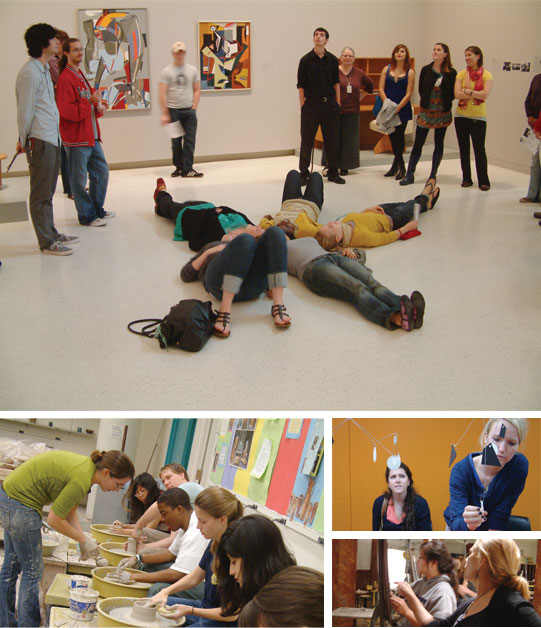 Hundreds of Pitt students visit and take art-making classes for free each year at the Oakland museums and The Warhol. Photos: Madelyn RoehrigThis past September, Pitt senior Chris Rampolla tried his hand at the “I Can’t Draw …Yet” class, which offers step-by-step drawing instruction. “I was a bit apprehensive going in because I was born with little-to-no artistic ability,” says Rampolla, a philosophy major who attended the class at the urging of a friend. “But I am pretty competitive so I wanted to come out being able to draw better, and by the end I was happy I had made progress.” Rampolla visited the museum often as a child growing up in Pittsburgh’s South Hills, but hadn’t returned on his own during his time at Pitt, even with the museums literally across the street. “I guess there are more attention-grabbing things for university students to do,” he says. Yet after the introductory workshop, he took a free stroll through Carnegie Museum of Art the next weekend using his student ID—and hopes to sign up for more drawing classes. “I’ve always been appreciative of art, mostly because I can’t do it,” he says. “But now it’s really interesting to better understand how an artist views the world.” Reaching out to college students like Rampolla at this intellectually formative time in their lives is a vital part of Carnegie Museums’ educational mission, says Marilyn Russell, chair and curator of education at Carnegie Museum of Art. “If you learn to be comfortable and curious in a museum as part of your college experience, it could become a lifelong habit and help shape how you approach new ideas and unfamiliar experiences,” Russell says. “The hands-on things my kids do at the museums are invaluable. Everything they see cements in their minds.”
Chris Olbeter, an Artstart participant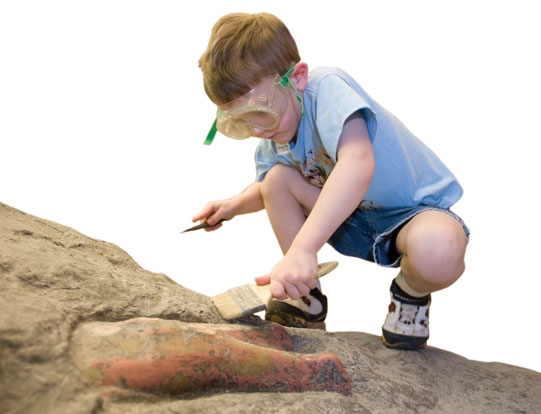 Another way of providing better museum access to the next generation of art enthusiasts is through ArtStart, a pilot initiative that this year provided free memberships to 16 low- to moderate-income families. Participants were identified in conjunction with The Hill House Association, a social service agency in the Hill District, and Beginning with Books, an early childhood literacy outreach center. Formerly called Stepping Stones, the program was discontinued in 2007 due to lack of funding and direction, says Jara Dorsey, who is working to rebuild and expand it. She aims to connect ArtStart families through an online community that provides a support network, and ultimately helps them become independent museum-goers. “Coming into any art museum can be an intimidating thing if you don’t know the art or how to interpret it,” Dorsey says. “If you have someone with you to bounce ideas off of, or to share the experience, it makes it that much richer—and hopefully makes you more likely to come back on your own.” Chris Olbeter couldn’t be more grateful. The Coraopolis woman homeschools her two teenage girls and 5-year-old son while her husband works for the U.S. Postal Service. Using their ArtStart membership, Olbeter’s daughters took a drawing class this fall at Carnegie Museum of Art, and they plan to spend long winter days in the four Carnegie Museums with their mother as their guide. “A $130 museum membership would be out of the question as a single-income, homeschooling family, so this was a real blessing,” Olbeter says. “The hands-on things my kids do at the museums are invaluable. Everything they see cements in their minds.” M is for MuseumsParents like Olbeter can also enroll their children in paid homeschooling classes at Carnegie Museums that help meet the challenges of teaching art and science. At the Museum of Natural History, for instance, homeschoolers ages 4 to 12 are currently immersed in hands-on adventures in archeology, forest ecology, and geology.Similar programs at Carnegie Science Center and the Museum of Art give homeschoolers the opportunity to join their peers in a more traditional group setting and also receive behind-the-scenes access to exhibitions with expert instruction. “At the most basic level, not every parent is an artist or a science enthusiast with the framework to provide this kind of discovery-based learning experience in a museum setting,” Russell says. Since first grade, 12-year-old Jonathan Mulick has been taking homeschool classes at Carnegie Museums, which often spur him to dig deeper into subjects he finds especially interesting, says his mother, Michele Mulick, of Mt. Washington. “I look at it as great enrichment and direct instruction,” Mulick says. “This is an extension of what we’re doing at home that also helps him understand he is part of a bigger community. He sees why these museums are here and what they do for our city.” Mulick’s son also is a regular participant in SciTech Days, a biannual program of Carnegie Science Center’s Regional SciTech Initiative that connects students with scientists and industry leaders in a fun, dynamic atmosphere. The workforce development event attracts about 6,000 middle-and high-school students over four days each November and March. They participate in hands-on workshops and demos designed to capture their interest in science and technology. Director Linda Ortenzo has worked closely with corporate sponsors to raise funds to ensure that about a third of the participating students come from underserved communities. “These are students who wouldn’t have an opportunity to come to the Science Center otherwise,” says Ortenzo, also noting the push to boost the number of girls and minorities at SciTech Days. “The jobs of the future are in the high-tech fields, so there’s a real underlying passion for us to introduce these children to these topics and careers.” Charlotte Jones, a library and information specialist at Cornell Intermediate School in the McKeesport School District, has been bringing busloads of her students to SciTech Days for the past two years. “I’m excited to teach kids to be excited about life, and inner-city kids don’t always have that,” Jones says. “SciTech gives my students the spark and energy to come back to school fired up to learn.” 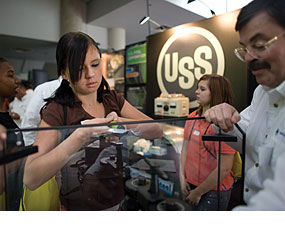 Last year, a grant from U.S. Steel Corporation made it possible for 90 Cornell fifth- and sixth-graders to get fired up at SciTech, including 10-year-old John Grayson (pictured on page 26). Grayson earned first-place during a robotics challenge at SciTech that required him to program a robot to negotiate a maze. He completed the exercise with a partner from another school district in a record 25 minutes, to the delight of the Carnegie Mellon University instructors who conceived it. Last year, a grant from U.S. Steel Corporation made it possible for 90 Cornell fifth- and sixth-graders to get fired up at SciTech, including 10-year-old John Grayson (pictured on page 26). Grayson earned first-place during a robotics challenge at SciTech that required him to program a robot to negotiate a maze. He completed the exercise with a partner from another school district in a record 25 minutes, to the delight of the Carnegie Mellon University instructors who conceived it.Some 6,000 middle- and high-school students attend SciTech Days in November and March.“The perseverance was incredible,” Jones says. “And John has gone from being a C student to an A student. SciTech gave him the self-esteem to ignore all the noise at school and come here to learn.” Grayson—now an aspiring roboticist—spends every free period he has in the library teaching himself about circuits, computers, and even calculus. Jones says it almost takes a crow bar to pry him away from his books in time for his next classes. “Now I know why calculus is important,” adds Grayson. “And I’m just really getting into it.” A treasure trove for teachers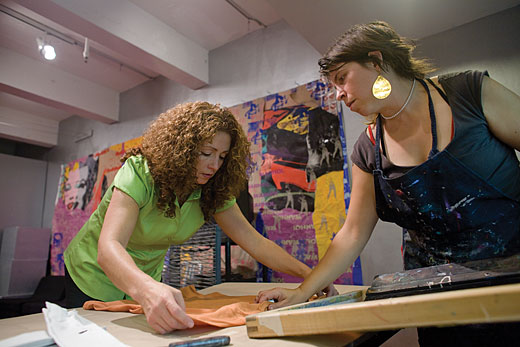 Cynthia Blackwell (left), with the help of artist-educator Mary Tremonte, tries her hand at silkscreening at a recent open house for teachers at The Warhol. Photo: Renee Rosensteel
Carnegie Museums is constantly reaching out to teachers to help keep learning fresh—and fun—no matter the discipline. For instance, Spanish-language teachers recently explored the possibilities of conversing with their students about giant flying reptiles and American Indian heritage—en Español, of course—using Carnegie Museum of Natural History exhibitions as a backdrop.Each of the four museums regularly hosts innovative onsite teacher-training workshops and open houses, many that satisfy state requirements for continuing education. Educators across the tri-state also take advantage of a free preview visit at Carnegie Science Center each year to get new ideas and discover unique programs they might be able to share with their students. “I want students to learn that their artistic skills can be used for self-expression, and to know about Warhol’s success so they come to view art as a career option.” - Cynthia Blackwell, arts educator at the Pittsburgh Gifted CenterAnd at The Andy Warhol Museum, teacher education has gone global, just like Andy’s artwork, thanks to the museum’s online educational curriculum that provides resources and in-depth lesson plans for arts and humanities instructors across the world. Lesson plans are available on The Warhol’s website in English, Russian, and Spanish. “Teachers are our conduit to reaching out to students and for really helping them understand the importance of art-making and art-viewing—that’s why we want to be a resource for teachers in any way we can,” says Nicole Dezelon, associate education curator for school and teacher programs at The Warhol. Cynthia Blackwell is a visual arts educator for middle school students at the Pittsburgh Gifted Center in the West End, and she frequently participates in professional development workshops at The Warhol and often brings her students to the museum for tours and education programs. One group used Warhol’s silkscreening technique to create a large mural incorporating their favorite toys that was later installed at the new Children’s Hospital of Pittsburgh of UPMC in Lawrenceville. This past summer, Blackwell also took advantage of research opportunities at the museum by traveling with Dezelon and 13 other area teachers on a five-week trip to Brazil on a Fulbright-Hays group project (the country’s Museum of Contemporary Art is a Warhol partner) to develop lesson plans about the intersections of art and society. Blackwell appreciates the interdisciplinary approach The Warhol takes toward arts education because drawing connections with primary subjects such as history and science is vital at a time when many school arts programs are on the chopping block. She also says participating in the one-of-a-kind programs at the museum has made her better equipped to make the life and art of Andy Warhol—and beyond—come alive for her students. “I want them to learn that their artistic skills can be used for self-expression, and to know about Warhol’s success so they come to view art as a career option,” she says. “But first and foremost, I want them to know the museum is here and available to them.” |
|
Also in this issue:
The Art of Daily Life · Putting the Popular in Science · Clearing a New Path · Directors' Note · NewsWorthy · Face Time: Lynn Zelevansky · Field Trip: For the Birds · Artistic License: Break-Out Performance · About Town: Social Science · Science & Nature: The Lord of the Flies · Big Picture
 |
Copyright © 2017 CARNEGIE Magazine. All rights reserved. |
